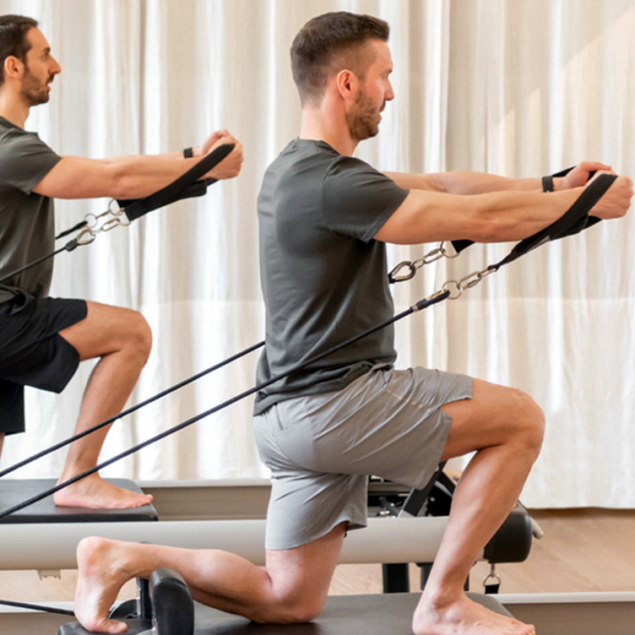
Over the last few years, Pilates has become the go-to exercise for health and wellness. Whether you’re looking to increase your strength and stability or achieve profound mental clarity, Pilates offers many health benefits. And if you’re considering booking your first Pilates class, you might be curious about what consistent practice can bring.
In this blog post, we’ll explore the history of this exercise and outline the various health benefits of Pilates when practised consistently.
Wondering when Pilates made its way into gym studios? It might surprise you to know it wasn’t a recent concept!
Pilates was developed by Joseph Pilates during the early 1920s. Originally called “Contrology,” Pilates emphasised the importance of the mind-body connection, control, precision and fluidity in movements. Joseph Pilates designed his method to improve physical strength, flexibility and posture while promoting mental clarity and relaxation.
Today, Pilates is practised worldwide, with two main types: mat Pilates and reformer Pilates. Mat Pilates involves exercises performed on a mat using body weight for resistance, while reformer Pilates uses a piece of equipment called a reformer. The major benefit of Pilates reformer is that it adds resistance through springs and pulleys, intensifying the workout.
Thinking about giving Pilates a try? Whether you’re thinking about heading to a studio three times a week or fortnightly, here are six major health benefits you can expect to see with consistent classes:
Whether you’ve read online or heard through a friend, one major benefit of Pilates is its significant improvement in core strength. The core, often called the powerhouse, includes the abdomen, lower back, hips and pelvis muscles. Pilates exercises target these muscles, enhancing stability and strength. A strong core not only improves overall physical performance but also reduces the risk of injuries and alleviates lower back pain.
Pilates incorporates a range of stretching exercises that increase flexibility and joint mobility. Regular practice helps lengthen and stretch muscles, improving flexibility over time. Being able to move more comfortably in daily activities can reduce the likelihood of injuries typically brought on by tight muscles and restricted movements.
From sitting at a desk all day to sleeping in bad positions, poor posture is a common issue that can lead to various health problems, including back and neck pain. Pilates focuses on proper alignment and body awareness, teaching individuals how to maintain correct posture during exercises and in daily life. Consistent practice helps develop the muscles needed to support a healthy posture, reducing strain on the spine and promoting overall spinal health.
Pilates is an excellent way to build lean muscle tone and strength. The exercises target various muscle groups, including the arms, legs and glutes, promoting balanced muscle development. Unlike traditional weight training, Pilates focuses on low-impact, controlled movements that minimise the risk of injury while effectively building strength and endurance.
Pilates is not only beneficial for physical health but also for mental well-being. The focus on controlled breathing and mindful movement promotes relaxation and reduces stress. Regular practice can improve mental clarity and boost your mood. The meditative aspects of Pilates provide a mental escape from daily stressors, contributing to a more balanced and peaceful state of mind.
One benefit of Pilates classes you might not realise is the social aspect it provides. Engaging with instructors and fellow participants creates a sense of community and accountability. The social interaction and shared experiences of regular classes can also boost motivation and make the exercise routine more enjoyable. Building relationships with others who share similar health and wellness goals can provide a supportive environment that encourages you to keep coming back for weekly classes.
Absolutely. Pilates is a versatile form of exercise that can be adapted to suit individuals of all ages and fitness levels. Whether you are a beginner or an experienced athlete, Pilates has many modifications and progressions to match your abilities. It is particularly beneficial for those recovering from injuries or managing chronic pain, as the low-impact nature of the exercises can minimise strain on the body.
Of course, it’s highly recommended to consult with your healthcare provider before engaging in a new workout routine, especially if you have any health conditions, or it’s been a while since you’ve exercised.
It’s understandable that booking your first Pilates class can be a little scary. But it’s important to be proud of yourself for having the courage to try something new! To ensure you walk away feeling empowered after your first session, check out our beginner tips below:
Begin your Pilates journey with KX Pilates
When you’re considering Pilates for the first time, choosing the right studio can make all the difference in your experience. KX Pilates is proud to offer 100+ inclusive and motivating studios nationwide. Our brilliant instructors are here to help you reach your fitness goals. Book your first class today and experience the transformative power of Pilates for yourself.